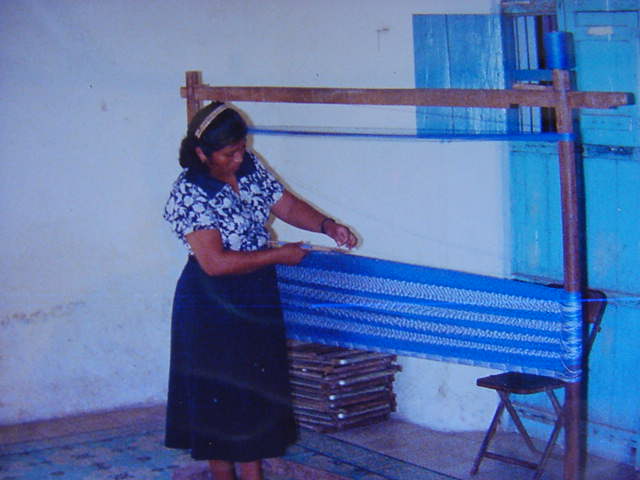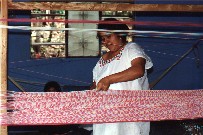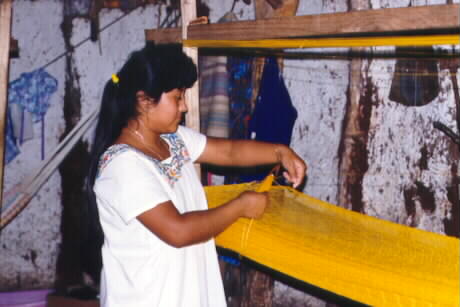A Cottage Industry in Ticul, México

A Cottage Industry in Ticul, México

On our trip to Ticúl we visited a hammock cottage industry. The word hammock in Mayan is Káan.
We arrived at our destination, which was the house of a local family our professor, Dr. Burns, had stayed with during one of his investigations. They were quite hospitable. One of their children guided us to the location where the hammocks were being made.
As we entered the room there was peeling green paint on the walls with some faded pictures, a blackboard, a desk, a clock, a fan and many chairs stacked up in a corner. In the other room there was a kitchen stove and table. This area was also used for storage. The floor was tiled. One woman was making a small sized hammock with navy blue and light blue nylon thread. She explained to us that nylon was preferred these days due to its durability. It is very popular not only among the tourists, but also the local population. Hammocks must be hand crafted, as there is no way to make them on a machine. It is a lost art that is being revived through governmental assistance to help mostly women learn a craft and be self-employed.

We quickly learned that during this time funds were scarce and hardly anyone was working because there was no more ¨conos¨ or cone shaped threads with which to make the hammocks. It seems that the government subsidizes this cottage industry in Ticúl. The coordinator fills out a requisition for the different types of "conos" textures and colors. The cost of one regular "cono" is $12 pesos. It is a thick nylon thread. There is a stronger thread called "elefante" which is thinner, but much stronger; it is more expensive, however, and they rarely order it. It takes the government three months to process the application. The government then allocates the amounts among the cooperatives as deemed appropriate. It is a way of rationing the supply of threads among all the cooperatives. Once the materials are utilized the cooperative must repay 50% of the government loan. Each cooperative must have at least 10 members in order to qualify for government funding and also it must be housed in a neutral locale, so the coordinator must rent a local establishment to house the cooperative. Subsidies are competitive. This particular locale was rented from the baker next door for $250 pesos monthly. There may be as many as 30 people making hammocks in a two room locale. Looms would then be placed about the rooms. One of the benefits of government subsidy is that they offer a scholarship program where students are paid $1,160 pesos monthly to learn a craft.
When the hammocks are finished the government may donate the newly made hammocks to local orphanages for homeless children. The student is allowed to keep a hammock for his or her own use and some hammocks may be sold at the marketplace. Although both men and women are encouraged to learn the art of hammock making, mostly women attend the classes. Men usually learn shoemaking instead, as seasons do not overlap. When there is a slow season for hammock making, shoemaking is still thriving. In that manner, the coordinator explained a family could still have income. However, during the slow season, many women must find employment at domestic servants to receive income.
During this off-season, the cooperative may conduct a raffle to raise money to buy "conos" with which to make hammocks or to pay the rent. They either donate items they have hand made themselves or sell off items they have at home they do not need.
Sometimes in the evenings other women go to the locale to make "hipiles," traditional white cotton dresses made with needlepoint designs. Or, they may gather to make general needlepoint crafts and talk with other community members in the neighborhood.
While students are learning the art of hammock making their hours are from 2 p.m. to 8 p.m., Monday through Friday, with 2 breaks. It usually takes two weeks for an apprentice to make a hammock. With about 30 students they can make 60 hammocks. These can sell for about $120 pesos for a small to $350 for a large. Whatever the sale amount is, they must give the government half of their sales.

The coordinator teaches the art of hammock making, although she is very modest and does not refer to herself as a teacher. She said they had a teacher there once who taught Spanish, but they did not like him and he no longer comes to their cooperative to teach them reading and writing. She has been weaving since she was a little girl and learned by watching others weave. The trick is to create a tight weave, she said. She uses a loom called a "bastidor", and a giant wooden needle called a "kaiché". The loom is about 6 to 8 feet long and the craftsman must stand for many hours moving from side to side as they weave. At first they develop blisters on their hands, then with time they turn to calluses. The coordinator showed us her callused hands. The crafts lady working on the single hammock had the same type of calluses. Since the two doorways remain open one can hear the traffic passing and smell the exhaust fumes. Sometimes women bring their children if they do not have anyone to leave them home with and they play on the floor while their parent learns the art or hammock weaving.

The coordinator and her helpers, experienced hammock weavers, demonstrate the craft and they themselves know intricate designs - some called olas, el perrito, arroz. They can be commissioned to make hammocks independently of the cooperative.
Once the students complete their training process, they no longer receive government scholarships. However, they can then organize a group of 10 persons and open their own cooperative and compete for government subsidy. They can train anyone who wants to learn.
|
back |
next |